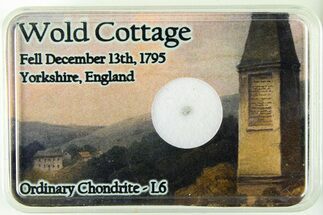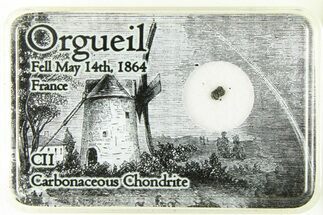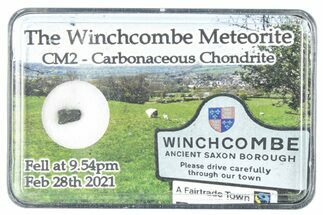This Specimen has been sold.
.06" L6 Chondrite Meteorite Fragment - Wold Cottage
This is a .06" wide fragment of the L6 chondrite known as Wold Cottage, a witnessed fall in Yorkshire in 1795 and one of the first meteorites ever thoroughly studied. Most of this meteorite is preserved in academic collections for research: it's quite rare to find this on the market!
This is quite a historic meteorite! This L6 chondrite fell near the village of Wold Newton in Yorkshire, England, at just about 3:00PM on December 13, 1795. It left a yard-wide crater in the ground, embedding itself into the chalk layer over 12 inches below the surface. In fact, it only landed a few yards from plowman John Shipley! The landowner, Major Edward Topham, exhibited the meteorite in London for a while before it changed hands and evnetualyl found its way to the British Museum in 1835. Today the meteorite is housed in London's Natural History Museum, and a small brick monument marks the site of its fall in Yorkshire.
The 25-kilogram mass is composed of stony portions similar to kaolin with inclusions of nickel-iron alloys and even some pyrites. It remains the largest witnessed fall in Britain and the second-largest witnessed fall in Europe.
The 25-kilogram mass is composed of stony portions similar to kaolin with inclusions of nickel-iron alloys and even some pyrites. It remains the largest witnessed fall in Britain and the second-largest witnessed fall in Europe.
About Chondrites
A chondrite is a stony (non-metallic) meteorite that has not been modified by either melting or differentiation of the parent body. Chondrites are formed when various types of dust and small grains in the early Solar System accreted to form primitive asteroids. Some such bodies are captured in the planet’s gravity well and pulled to the surface. They are by far the most common type of meteorite, representing about 86 percent of all meteorites that have fallen to Earth.
Prominent among the components present in chondrites are the enigmatic chondrules, millimeter-sized spherical objects that originated as freely floating, molten or partially molten droplets in space; most chondrules are rich in the silicate minerals olivine and pyroxene. Chondrites also contain particles of various metals such as nickel, iron, and aluminum. These formed at the very beginning of the solar system and aggregated over time: they are the oldest rocks known on Earth!
Chondrites are divided into about fifteen distinct groups on the basis of their mineralogy, bulk chemical composition, and oxygen isotope compositions. The various chondrite groups likely originated on separate asteroids or groups of related asteroids. Each chondrite group has a distinctive mixture of chondrules, refractory inclusions, matrix (dust), characteristic chondrule sizes, and other components. Other ways of classifying chondrites include weathering and shock. The L chondrite group is the most common of these.
A chondrite is a stony (non-metallic) meteorite that has not been modified by either melting or differentiation of the parent body. Chondrites are formed when various types of dust and small grains in the early Solar System accreted to form primitive asteroids. Some such bodies are captured in the planet’s gravity well and pulled to the surface. They are by far the most common type of meteorite, representing about 86 percent of all meteorites that have fallen to Earth.
Prominent among the components present in chondrites are the enigmatic chondrules, millimeter-sized spherical objects that originated as freely floating, molten or partially molten droplets in space; most chondrules are rich in the silicate minerals olivine and pyroxene. Chondrites also contain particles of various metals such as nickel, iron, and aluminum. These formed at the very beginning of the solar system and aggregated over time: they are the oldest rocks known on Earth!
Chondrites are divided into about fifteen distinct groups on the basis of their mineralogy, bulk chemical composition, and oxygen isotope compositions. The various chondrite groups likely originated on separate asteroids or groups of related asteroids. Each chondrite group has a distinctive mixture of chondrules, refractory inclusions, matrix (dust), characteristic chondrule sizes, and other components. Other ways of classifying chondrites include weathering and shock. The L chondrite group is the most common of these.
TYPE
Ordinary Chondrite (L6)
LOCATION
Wold Newton, Yorkshire, England
SIZE
.06" wide
CATEGORY
ITEM
#285350
 Reviews
Reviews












